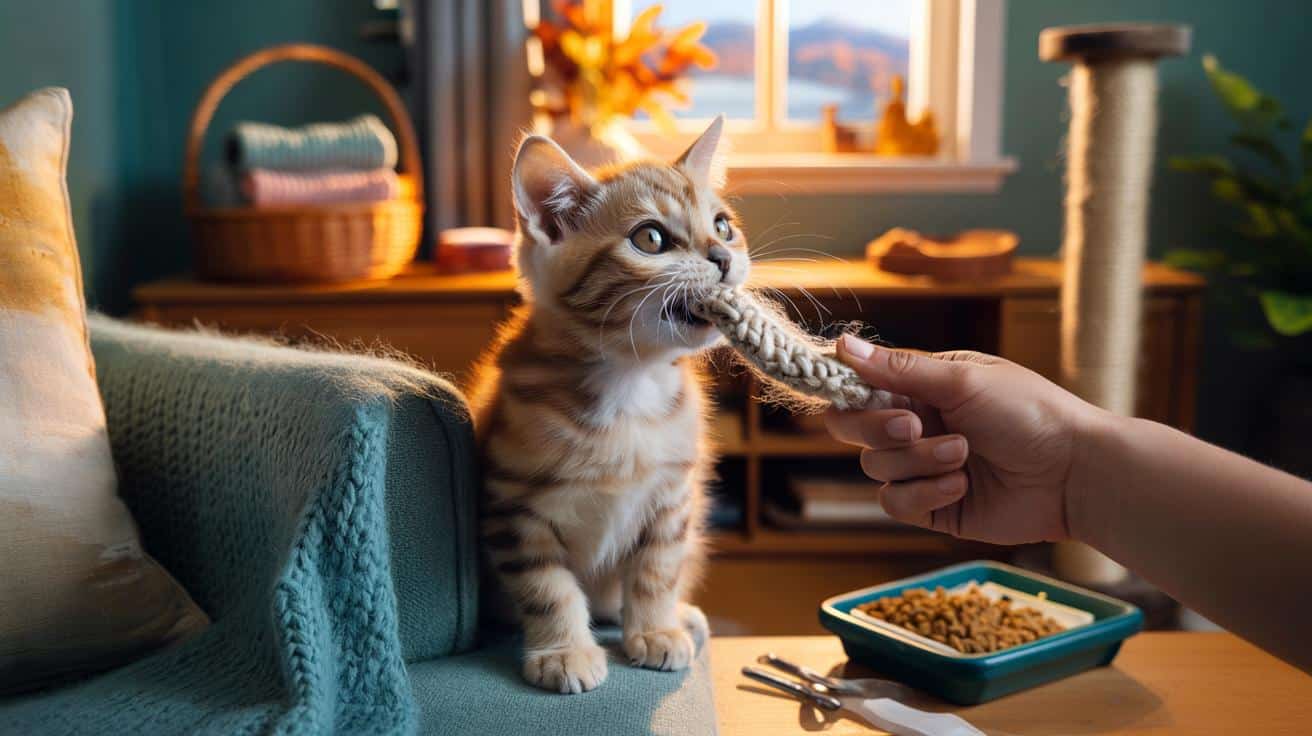Many readers ask why their cat targets knitwear at night so often.
We looked at behaviour patterns, seasonal triggers, and practical fixes you can start today. Here is what changes, what it costs, and how fast you can expect results.
Why cats chew clothes in autumn and beyond
Chewing fabric is rarely mischief for mischief’s sake. It signals a need. Shorter days reduce window-watching and outdoor stimulation. Indoor cats burn nervous energy by mouthing wool, cotton, or strings. Some seek texture that mimics prey. Others self-soothe when alone. A few show signs of pica, where non-food items attract them.
Feeding patterns matter too. A low-fibre diet may leave a cat under-satisfied between meals. Early weaning can drive “wool-sucking” in certain lines, notably oriental breeds. Dental discomfort can also push a cat to seek relief with softer fabrics.
Chewing is communication, not spite. Treat the need, not the jumper.
| Cause | Signs you might see | Try first |
|---|---|---|
| Boredom or stress | Chewing in the evening, after a quiet day, or when you leave the room | Two short play sessions daily; foraging toys; predictable routines |
| Texture craving or early weaning | Preference for wool and fleeces; kneading while mouthing | Fabric-safe chew toys; fleece tug strips; soft chew sticks for cats |
| Fibre hunger | Chewing plant-like textiles; frequent snacking urges | Add safe fibre sources; use slow-feeder bowls; split meals |
| Dental discomfort | Chewing on one side; drool; pawing at mouth; foul breath | Book a dental check; offer soft chew toys; avoid stringy fabrics |
| Pica or compulsive pattern | Persistent fabric eating; vomiting threads; restlessness | Vet assessment; rule out deficiencies; strict garment storage |
Five fixes you can start today
- Set a 10–12 minute “hunt” twice a day. Use a wand toy to copy the stalk–chase–pounce sequence. End with food to complete the cycle and reduce fabric-seeking.
- Offer chew-safe alternatives. Rotate three items: a catnip or valerian plush, a rubberised dental chew, and a fleece plait. Replace worn toys every two to three months.
- Feed for calm. Add a teaspoon of cooked pumpkin or a veterinary fibre topper for adult cats that tolerate it. Use puzzle feeders to spread intake across the evening peak.
- Store and deter. Put knitwear in lidded baskets. Use a cat-safe bitter spray on furniture edges, not on clothes you plan to wear. Supervise first contact to gauge reaction.
- Reward the behaviour you want. Redirect gently the second teeth touch fabric. Hand the chew toy, then praise and treat. Consistency turns choice into habit within two weeks for many homes.
Redirect within two seconds, reward within five. Timing turns a nibbler into a play partner.
Your seven-day reset plan
Day-by-day structure builds momentum and trims costs that spiral when jumpers keep getting replaced.
- Day 1: Remove temptation. Box up loose woollens, cords, and tasselled throws. Place two chew toys where the cat usually sits.
- Day 2: Introduce a morning play block. Finish with a tablespoon of regular food in a puzzle feeder.
- Day 3: Add an evening wand session. Dim lights slightly to match crepuscular instincts.
- Day 4: Swap in a new texture toy. Rub with catnip if your cat responds, skip if it causes over-arousal.
- Day 5: Create vertical routes. One extra shelf or a window perch gives a new focus within minutes.
- Day 6: Trial a fibre tweak if suitable. Monitor stool quality and appetite.
- Day 7: Review hotspots. Use a bitter spray on chair corners only if chewing persists there.
What changes to expect and when
Most households report fewer fabric raids once play and feeding patterns settle. Nights go quieter first, then afternoons. Cats often redirect to the new chew options within several days. Replace or rotate toys weekly to keep novelty working for you.
Savings can be real. A single ruined jumper costs £35–£120 to replace. A month of chew toys and a puzzle feeder often sits under £25. Time investment is modest: two short sessions daily outcompete the cost of shredded knitwear fast.
Small, regular effort beats one big purchase. Routine is the currency cats trust.
When you should call the vet
Seek a clinical view if any cloth is swallowed or threads go missing. Watch for vomiting, constipation, belly pain, or lethargy. Sudden chewing in an adult cat can flag dental pain, nausea, or anxiety. Kittens that wool-suck may need extra feeding structure and careful monitoring. Breeds with a history of wool-sucking may benefit from early habit-shaping and more frequent play windows.
Smart prevention you can set and forget
Build friction into storage. Lidded bins for laundry, hooks for dressing gowns, and zipped bags for wool keep cues out of reach. Design the room so a cat sees a perch, a scratch point, and a chew toy before it sees a sleeve. Change just one layout element every fortnight to refresh interest without chaos.
Make simple chewables that you will not miss. Twist three fleece strips into a plait and knot the ends. Freeze it for 15 minutes for added novelty. Offer it after play, not instead of play.
Extra context, risks, and useful add-ons
Pica carries risks beyond a torn jumper. Threads can saw through intestines or bunch up in the stomach. Avoid string toys unless you supervise. Do not yank fabric from a cat’s mouth; trade with a high-value treat to avoid accidental injury.
Consider scent. Some laundry detergents leave residues that either attract or repel. If a particular pile gets targeted, switch to a fragrance-free option for two weeks and observe change. A mild shift in smell can stop a habit before it sticks.
Try a simple simulation to test your plan. For seven days, log chewing attempts, time of day, and what you changed. Aim for a 30–50 percent drop by day seven. If you do not see movement, increase play intensity, reduce access further, and ask your vet about diet and dental checks.
Combine strategies for stability. Chew toys without play often fail. Diet tweaks without storage changes invite relapse. A short, repeatable routine—play, chew, food, rest—meets the need that clothes accidentally fulfil.








